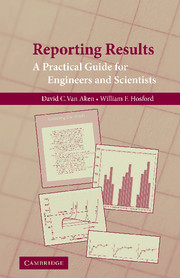Book contents
- Frontmatter
- Contents
- Preface
- REPORTING RESULTS
- 1 Elements of Technical Writing
- 2 Technical Papers
- 3 Technical Letters
- 4 Oral Presentations
- 5 Presentation of Technical Data
- 6 Statistical Analysis of Experimental Data
- 7 Resumé Writing
- Appendix I COMMON ERRORS IN WRITING
- Appendix II PUNCTUATION
- Appendix III COMMON WORD ERRORS
- Appendix IV INTERNATIONAL SYSTEM OF PREFIXES AND UNITS
- Appendix V THE GREEK ALPHABET AND TYPICAL USES
- Appendix VI STRAIGHT-LINE PLOTS FOR SOME MATHEMATICAL FUNCTIONS
- References
- Index
- References
2 - Technical Papers
Published online by Cambridge University Press: 05 September 2012
- Frontmatter
- Contents
- Preface
- REPORTING RESULTS
- 1 Elements of Technical Writing
- 2 Technical Papers
- 3 Technical Letters
- 4 Oral Presentations
- 5 Presentation of Technical Data
- 6 Statistical Analysis of Experimental Data
- 7 Resumé Writing
- Appendix I COMMON ERRORS IN WRITING
- Appendix II PUNCTUATION
- Appendix III COMMON WORD ERRORS
- Appendix IV INTERNATIONAL SYSTEM OF PREFIXES AND UNITS
- Appendix V THE GREEK ALPHABET AND TYPICAL USES
- Appendix VI STRAIGHT-LINE PLOTS FOR SOME MATHEMATICAL FUNCTIONS
- References
- Index
- References
Summary
Technical papers are a principal means of communicating within the scientific community. They are gener- ally archival in nature and follow prescribed formats dependent on the journal or publisher. Laboratory instructors may require a format similar to a technical journal, and students will find this chapter useful in preparing their technical reports. Corporations and government agencies may have different requirements; these are not addressed here. This chapter describes various formats and describes how the general subsections – abstract, background, experimental procedures, results, discussion, summary, acknowledgments, and references – should be written.
Format
There are various formats that can be used for technical papers. The format should use headings and subheadings that divide the text into convenient portions. Formats are designed for optimum communication to the reader and can provide easily recognizable locations in the text to which the reader can return after interruption. Also, important results can be associated with specific headings, helping the reader find information of interest. Although no set format is best for all technical reports, all formats require concise but complete documentation.
A simple format for a technical paper or report contains the following: title, abstract, introduction, results, discussion, conclusions, acknowledgments, references, and appendices. The title page contains the title of the paper and the authors' names and affiliations. Any figures and tables should be incorporated into the body of the text as soon after they are referred to as is convenient, or they can be collected at the end of the report.
- Type
- Chapter
- Information
- Reporting ResultsA Practical Guide for Engineers and Scientists, pp. 13 - 25Publisher: Cambridge University PressPrint publication year: 2008



